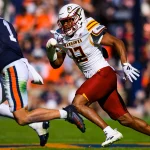Senquez Golson could feel himself hitting a wall.
It was the spring of 2012, and as the calendar turned to May, fatigue began to set in.

Golson was roughly six months removed from his first season of college football, a freshman campaign that saw him play in all 12 games and make four starts at defensive back on an Ole Miss team that cratered to a 2-10 record in a 2011 campaign so putrid it prompted a coaching change.
Nearly all Division I athletes use the offseason as a time to recuperate their body, get stronger and refine their skill set. Golson had never had an offseason in his life and was in the middle of a 63-game baseball season in which he saw sporadic playing time. He appeared in 22 games and made 15 starts. A two-sport athlete in high school, the Pascagoula native turned down $1.35 million as an eighth-round draft pick of the Boston Red Sox in the 2011 MLB draft to play both baseball and football at Ole Miss.
Incoming freshmen Jerrion Ealy and John Rhys Plumlee will try to tackle the same feat over the next couple of years. Ealy is a five star running back who, at one point, was projected to be a first-round pick in the MLB draft before a pedestrian senior year at the plate caused his stock to tumble. Plumlee is a four-star athlete who will play quarterback for the Rebels.
Golson has been in their shoes. He’s lived the challenges that come with playing two sports, one of which is the physical toll.
“I’d talk to other guys that play football in other conferences, they’re schedule isn’t as strict as ours,” Golson said. “But that is what it takes when you have to play LSU one week, Auburn the next and Alabama the next. That is what it takes. The most difficult part was hitting that wall during baseball season. I would be hustling all fall. You don’t really get a break.”
Anthony Alford knows all about the physical toll Golson is referring to. Football was Alford’s first love, but baseball eventually became his occupation. He too grew up a two-sport star and was in the position Ealy and Plumlee are currently in, he couldn’t bring himself to choose between baseball and football. So the Petal native decided to do both. His original plan was to stay home and play football and baseball at Southern Miss. But then the Toronto Blue Jays entered the picture with an offer Alford couldn’t pass up: Sign for $750,000, play college football and play summer ball with the club when the school year ended. Alford called it a no-brainer.
“For three or four years, I never had an offseason,” Alford said. “It was tough on my body. I never gave my body a rest for three years. I was playing some type of sport year-round.”
Two south-Mississippi kids a year apart chasing their dreams, both uncertain of what sport would shape their future. Both hell-bent on finding out. Alford favored football coming out of high school. Golson favored baseball. Each ended up pursuing the latter sport professionally.
Both came to college as dual-sport athletes. The physical and mental strain eventually nudged them toward one sport and away from another. Golson always felt as if he was constantly playing catchup, overwhelmed by the year-round schedule that engulfed his life.
“It feels impossible. Especially in the SEC as a freshman, everything is so fast,” Golson said. “If I had just had someone to sit me down and say this is how this goes, it would have helped.”
The absence of an offseason not only took a toll on his body but also robbed him of an opportunity to refine each skillset. In the fall, instead of participating in fall baseball he was playing cornerback. In the spring, he forfeited spring football in favor of a bat and glove. So where’s the time to catch up? A varying, albeit small, handful of weeks between the two seasons. As soon as football season ended, Golson would begin to shag fly balls and hit in the cage.
“Baseball is just difficult thing to take off from,” Golson said. “Hitting, throwing, hitting the cutoff man. I have to get a groove back. I even work out now and miss a throw left, right, over this guy’s head. You have to get your timing back. You have to be able to time pitching. At that level, pitchers have a plan. They look at those charts, know your weaknesses and they pitch to it.”
When baseball ended, Golson, a high school running back, spent the rest of the summer trying to refresh his memory on the nuances of playing defensive back — a position he had little to no experience playing until arriving in Oxford.
It was a never-ending, year-round exercise as Golson tried to juggle to two. In the spring, he was absent from the Manning Center and unable to defend his post as starting corner, something particularly problematic as the program changed head coaches after Golson’s freshman year as Hugh Freeze took over for Houston Nutt.
“I am teetering with both of these, I don’t feel like either is giving me a 100 percent shot because I am going back-and-forth between two sports,” Golson said. “Think about it: You have a new coach coming in and his starting DB is gone all spring.”
Golson swears he didn’t become a good, SEC-caliber corner until his junior season, which coincidently came months after one of the bigger decisions of his life. The physical toll, coupled with the constant feeling of stagnant development in each sport pushed him to make a decision on which sport to play. Except it wasn’t really a decision at all.
Only one sport offered the opportunity to go to school for free. “Football was paying the bills. That is just the way it was,” Golson said.
Alford’s decision manifested in a much different way. He knew it loomed from the time he left high school. The option the Blue Jays with two things: A significant amount of money and an opportunity to play college football — the sport he first fell in love with. Alford gave himself a three-year ultimatum to choose a sport, though – whether consciously or subconsciously — knew which path he would eventually venture down. College offered him a chance to rid him of his football itch.
“I have no regrets,” Alford said. “Me going to college and getting football out of my system. It allowed me to focus on baseball.”
Alford’s schedule was much different than Golson’s. During the school year, Alford was solely a football player and a student. After spring football ended, Alford hit in the cage for six weeks in preparation for a summer of baseball. After finals ended in early May, he reported to extended spring training. From there, he was shipped off to one of the Blue Jays’ low-level affiliates to play for a handful of weeks before returning to campus for the start of fall camp.
It was a different path, but like Golson, Alford never saw an offseason.
“I definitely felt it physically,” Alford said. “Some of it is getting older, too. I just feel like your body needs to rest at some point. I come home from a full season of baseball now and I just want to do recover. When you don’t give your body a rest, it will tell you. It will break down on you with random injuries.”
Alford played in nine games at quarterback his freshman year at Southern Miss. He then transferred to Ole Miss, moved to the secondary and sat out the 2013 season. Alford and Golson were now playing in the same defensive backfield on the same team Golson says the companionship helped, albeit for a brief amount of time, and thinks it is something Ealy and Plumlee will benefit greatly from — having someone to throw and hit in the cage with, someone with the same schedule and someone to relate to — Golson and Alford didn’t have that for most of their journey.
“If I had had that extra guy, it would have helped,” Golson said. “Anthony Alford was around for a while, I was actually getting some baseball in for a little bit. With a little bit of advice and someone to go through it with, they can make it happen.”
As the 2014 season approached, Alford battled fatigue and floundered amongst a crowded depth chart that eventually became the best defense in college football. Alford got married that summer and felt as if his life was beginning to take shape. He had arrived at the three-year ultimatum he set when he left high school. Four games into the 2014 season, Alford decided to permanently hang up the cleats and shoulder pads in favor of a wooden bat and glove.
I was a peace with it,” Alford said. “I had to do what was best for my family and my wife. I am glad I was able to go to college and get it out of my system.”
Golson and Alford went down different paths and their stories are mostly written. Golson signed a four-year rookie contract with the stealers worth $4 million with $2.2 million guaranteed. He never played an NFL snap due to a trio of injuries suffered in training camp. Alford is toiling away in Triple-A. He was called up to The Show in May of 2017 and has bounced back-and-forth between Toronto and Triple-A Buffalo since.
Ealy and Plumlee are two weeks into fall camp as they prepare for their first year of SEC football. Plumlee is competing for the backup quarterback job. Ealy is trying to carve out a role in a crowded running back room. They sit in a similar spot to Alford and the same one as Golson, trying to balance two major college sports. But they’re doing it together, which the other two didn’t have the benefit of.
“When you are doing a workload like that, when you do it alone, it’s like ‘this kind of sucks,’” Plumlee said.”But having a teammate to do it with, you can get through it a whole lot easier. That isn’t to say we won’t enjoy it. We will. But it will be rigorous and time consuming for sure.:
Alford and Plumlee are from the same neck of the woods. Plumlee went to Oak Grove, a rival of Alford’s Petal Panthers. They’ve spoken over the phone. Alford has offered advice on how to manage the time and the strenuous workload. Both Ealy and Plumlee understand a challenging road lies ahead, but it is something they embrace.
“Having John Rhys is a big blessing,” Ealy said. “We go through this at the same time. It is easier for communication as well. They have to listen to two people instead of one. It makes it easier.”
Golson and Alford were eventually pressed into a decision. Ealy and Plumlee, in all likelihood, will ultimately arrive at a similar place. How far down the two-sport path will each go? When will that decision come? That’s the great uncertainty, but it’s also why they are at Ole Miss. Going to school offered the same thing that enticed Golson and Alford: to kick the can down the road and procrastinate the looming choice, to be able to play both sports and have a longer window to make a sound decision.
“I just feel like the best option right now is to come here, get my degree and play football and baseball,” Ealy said. “My heart is still with baseball, but I love football too. I love them both. I am going to continue to do them both as long as I can.”
Part of Alford’s advice to Plumlee was to enjoy being a kid. Enjoy being a kid immersed in the college experience because it lasts a finite amount of time.
Golson’s advice for the two as they head down this dual-sport road comes from a saying coined by his former football teammate Cliff Coleman.
“Shoot, they may as well get married,” Golson said. “Life’s a struggle. Find you someone to struggle with.”






